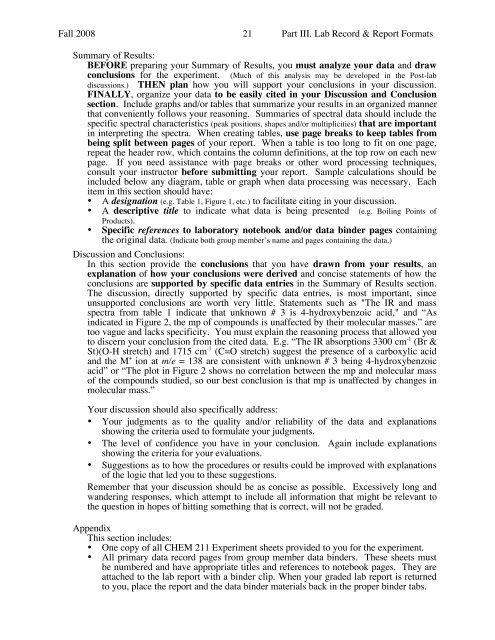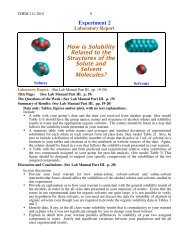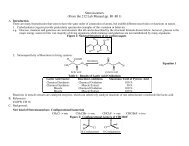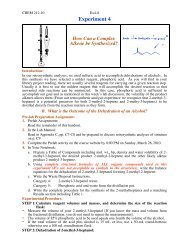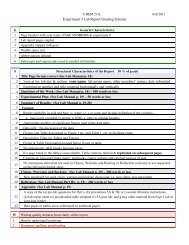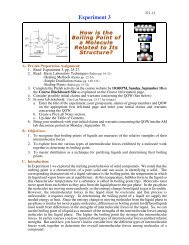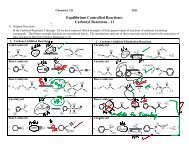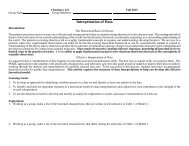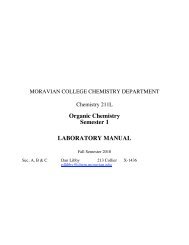Organic Chemistry Semester 1 LABORATORY MANUAL - Moravian ...
Organic Chemistry Semester 1 LABORATORY MANUAL - Moravian ...
Organic Chemistry Semester 1 LABORATORY MANUAL - Moravian ...
You also want an ePaper? Increase the reach of your titles
YUMPU automatically turns print PDFs into web optimized ePapers that Google loves.
Fall 2008 21 Part III. Lab Record & Report Formats<br />
Summary of Results:<br />
BEFORE preparing your Summary of Results, you must analyze your data and draw<br />
conclusions for the experiment. (Much of this analysis may be developed in the Post-lab<br />
discussions.) THEN plan how you will support your conclusions in your discussion.<br />
FINALLY, organize your data to be easily cited in your Discussion and Conclusion<br />
section. Include graphs and/or tables that summarize your results in an organized manner<br />
that conveniently follows your reasoning. Summaries of spectral data should include the<br />
specific spectral characteristics (peak positions, shapes and/or multiplicities) that are important<br />
in interpreting the spectra. When creating tables, use page breaks to keep tables from<br />
being split between pages of your report. When a table is too long to fit on one page,<br />
repeat the header row, which contains the column definitions, at the top row on each new<br />
page. If you need assistance with page breaks or other word processing techniques,<br />
consult your instructor before submitting your report. Sample calculations should be<br />
included below any diagram, table or graph when data processing was necessary. Each<br />
item in this section should have:<br />
• A designation (e.g. Table 1, Figure 1, etc.) to facilitate citing in your discussion.<br />
• A descriptive title to indicate what data is being presented (e.g. Boiling Points of<br />
Products).<br />
• Specific references to laboratory notebook and/or data binder pages containing<br />
the original data. (Indicate both group member’s name and pages containing the data.)<br />
Discussion and Conclusions:<br />
In this section provide the conclusions that you have drawn from your results, an<br />
explanation of how your conclusions were derived and concise statements of how the<br />
conclusions are supported by specific data entries in the Summary of Results section.<br />
The discussion, directly supported by specific data entries, is most important, since<br />
unsupported conclusions are worth very little. Statements such as "The IR and mass<br />
spectra from table 1 indicate that unknown # 3 is 4-hydroxybenzoic acid," and “As<br />
indicated in Figure 2, the mp of compounds is unaffected by their molecular masses.” are<br />
too vague and lacks specificity. You must explain the reasoning process that allowed you<br />
to discern your conclusion from the cited data. E.g. “The IR absorptions 3300 cm -1 (Br &<br />
St)(O-H stretch) and 1715 cm -1 (C=O stretch) suggest the presence of a carboxylic acid<br />
and the M + ion at m/e = 138 are consistent with unknown # 3 being 4-hydroxybenzoic<br />
acid” or “The plot in Figure 2 shows no correlation between the mp and molecular mass<br />
of the compounds studied, so our best conclusion is that mp is unaffected by changes in<br />
molecular mass.”<br />
Your discussion should also specifically address:<br />
• Your judgments as to the quality and/or reliability of the data and explanations<br />
showing the criteria used to formulate your judgments.<br />
• The level of confidence you have in your conclusion. Again include explanations<br />
showing the criteria for your evaluations.<br />
• Suggestions as to how the procedures or results could be improved with explanations<br />
of the logic that led you to these suggestions.<br />
Remember that your discussion should be as concise as possible. Excessively long and<br />
wandering responses, which attempt to include all information that might be relevant to<br />
the question in hopes of hitting something that is correct, will not be graded.<br />
Appendix<br />
This section includes:<br />
• One copy of all CHEM 211 Experiment sheets provided to you for the experiment.<br />
• All primary data record pages from group member data binders. These sheets must<br />
be numbered and have appropriate titles and references to notebook pages. They are<br />
attached to the lab report with a binder clip. When your graded lab report is returned<br />
to you, place the report and the data binder materials back in the proper binder tabs.


